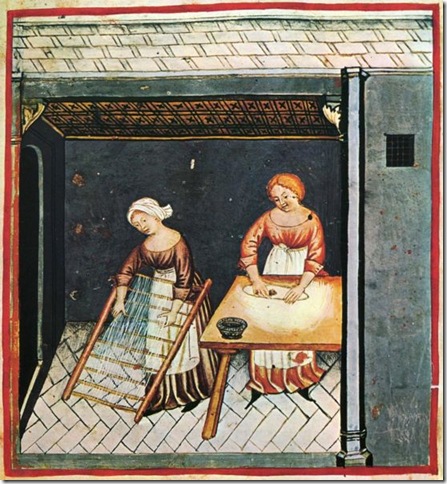Pasta – part 2 Posted by Serena on Oct 3, 2010 in Culture
La Storia della Pasta (The History of Pasta)
Above, preparazione della pasta nel XIV secolo. (pasta preparation in the 14th century).
Origins
Pasta, which is so closely linked to Italian culture, is in fact a universal foodstuff whose origins can be traced back to l’età neolitica, circa 8000 a.C. (the new stone age, around 8000 B.C.), when man first learnt to cultivate cereals, grind grain, and mix it with water to form a paste which was then dried in the sun for conservation.
The Chinese
In Lajia, north western China, a 4000 year old plate of spaghetti was discovered buried under 3 meters of sediment, it was probably well past its data di scadenza (‘best before’ date)! This, however, is the earliest datable evidence of the existence of pasta. Yet the Chinese invention of pasta is generally considered independent from that of the West, especially because all’epoca (at that time) the Chinese didn’t use frumento (wheat), which is characteristic of European and Arabic pasta.
The Etruscans
In fact, evidence of pasta production has been found in the archeological remnants of Greek, Roman, Etruscan, and Arabic culture. In the Etruscan tomb of Grotta Bella, at Cerveteri, for example, which dates back to il IV secolo a.C. (the forth century B.C.), there is evidence of implements such as la spianatoia, il mattarello e la rotella per tagliare (the working surface, the rolling pin, and the cutting wheel), tools which are still used today in pasta production.
The Greeks and Romans
The Greek authors Aristofane and Orazio describe a pasta of flour and water, rolled out and cut into slices, which they call làganon (Greek) or laganum (Latin). In the south of Italy the word lagane or laina is still used to describe this type of pasta which, although originally considered a dish for the poor, managed to acquire enough status in ancient Rome to be included in the fourth edition of De re coquinaria (The Culinary Art), a collection of recipes compiled in 230 d.C. (230 A.D.) by the Roman cook Celio, and attributed to the gastronome Apicio. Apicio describes in minute detail the condiments which were usually served with laganum, but unfortunately neglects to include the instructions for their preparation!
Arabic Culture and the Italian Peninsula
The 9th century Arabian musician and passionate gastronome Ziryab, described dishes prepared with a flour and water paste very similar to modern day pasta. In about 1145, Al-Idrisi, the renowned Berber geographer and traveler, was invited to the court of il re Normanno Ruggero II di Sicilia (the Norman king Ruggero II of Sicily). In his book ‘Libro di Ruggero II’ Al-Idrisi describes the village of Trabia, 30 km from Palermo, a village of mills where a string like pasta called itrya (from the Arabic itryah) was produced. This pasta was exported aboard ships bound for ports, both Muslim and Christian, throughout the Mediterranean.
To be continued …

Build vocabulary, practice pronunciation, and more with Transparent Language Online. Available anytime, anywhere, on any device.





Comments:
James Lupori:
After having just returned from 6 wonderful weeks in Italy (N. Tuscany and Torino) this post adds a whole new layer of understanding about Italian cuisine. We had an opportunity to visit Eataly in Torino and seeing the vast diversity of Italian pastas is overwhelming.
Thanks for a great post.
Tony Vizzini:
Why is there this strong popular belief , that it was Marco Polo who introduced the spaghetti to Italy when he came back from China ???
Did china invent spaghetti ???
Who invented pizza ???
I was born and lived in Sicily for 21 years before I went to Torino for my military service and then remained in Torino for 7 years before going to Canada for 6.
Now I have lived in Los Angeles for 36 years.
Thanks
Tony Vizzini
serena:
@Tony Vizzini Salve Tony,
The legend about Marco Polo having introduced pasta to Italy was fabricated by American industrialists and published in the American journal Macaroni Journal. The idea was to promote pasta as a foodstuff in America and to back the large scale cultivation of Durham wheat, which is used in pasta production.
As a wrote in my article, the Chinese invention of pasta is considered independent from that of the Western and Arabic cultures mainly because the Chinese didn’t use frumento, which is the basis of our pasta here in Italy.
As for the invention of pizza, well that’s another story, and you’ll have to wait for my pizza blogs, which I’ll write when I’ve done more research!
Hai vissuto una vita interessante mi pare, ma allora ti consideri Italiano, o Americano? Ti mancano le tue radici?
Saluti da Serena
Geoff Smith:
This is really interesting – I really love pasta and have always presumed it can from Italy!! The best pasta story was when the BBC did an April Fool that spaghetti grew on trees. Half the UK fell for it (it was back in the 1950’s when spaghetti was just getting popular.)
Serena:
@Geoff Smith Salve Geoff, your post was originally marked as spam due to the link which you gave to a commercial website. The link has now been removed, and I have approved your comment in the good faith that it is genuine.
Saluti da Serena
Tony T:
Your last line says to be continued. Hopefully you are keeping up your research on pasta as I love the history of food as much as I love eating it ( pasta is my favorite). 🙂
Thanks for a great post.
Tony T
Serena:
@Tony T Don’t worry Tony, it’s in the works!
A presto Serena